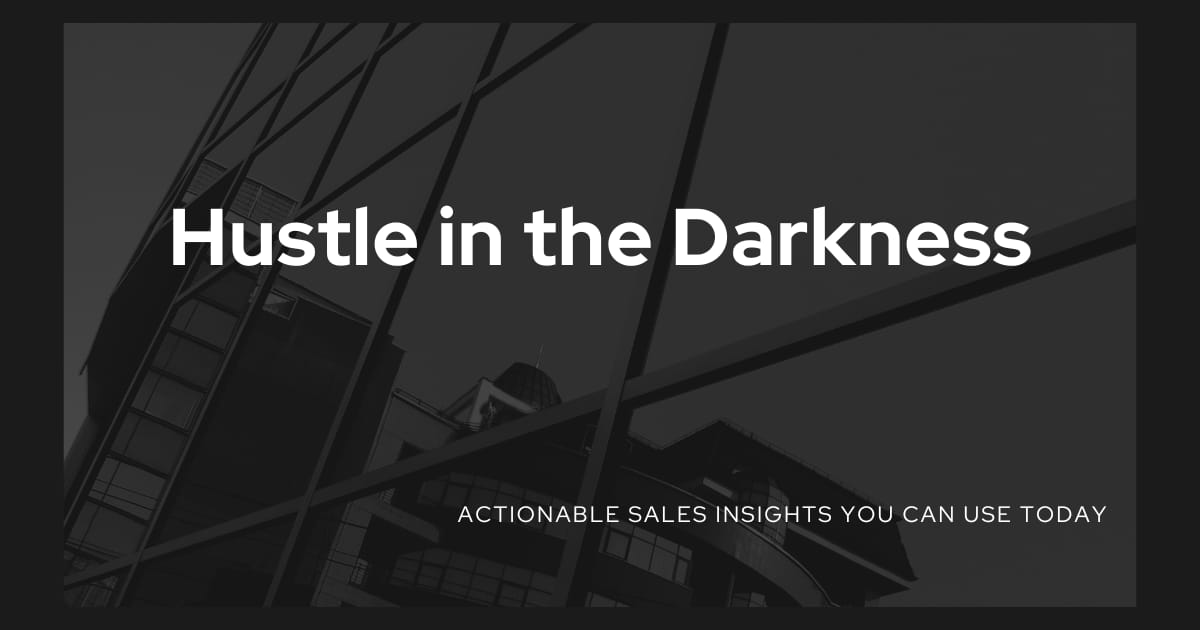Read on: My website
Read time: 2 Minutes
Your time is money and you should cherish it. The last thing you want to do is waste your valuable resources on projects where you have no chance of winning.
You also don’t want to submit a proposal to a project, lose, and then reflect back and think “Ya know…we really should have no go this opportunity” or have other reservations along the way.
The Go/No-Go decision is a critical meeting that needs to be taken seriously. Its primary purpose is to help you and your company make informed decisions on focusing on measurable factors. It is to simplify the complex decisions that need to be made.
Was this newsletter forwarded to you?
This can be on the proposal, allocation of resources, understanding the decision-makers, technical and product fit, the list goes on.
Too many companies treat their Go/No-Go meetings as mere formalities, missing the strategic opportunity to align resources, mitigate risks, and capture high-value opportunities.
Don’t just breeze through it do what the decision gates are meant to do because it can help you get clarity on either pursuing an opportunity or not.
Let’s dance.
Learn AI in 5 minutes a day
This is the easiest way for a busy person wanting to learn AI in as little time as possible:
Sign up for The Rundown AI newsletter
They send you 5-minute email updates on the latest AI news and how to use it
You learn how to become 2x more productive by leveraging AI
First Touch - Why Should I Care About This?
Time is the most valuable asset in business. Your Go/No-Go process is the backbone of your strategic decision-making. Yet, too often, it’s undermined by inconsistent practices and gut-feel decisions that can derail your long-term success.
A well-designed Go/No-Go decision can help do several things for an opportunity. It can:
Allocate additional resources (i.e., marketing, consultants, proposal, partners, subcontractors, etc.)
What does the competition look like?
Address accountability among the company and business development team
Address gaps in the pursuit (ie., technical, legal, contractual, policy, partners, etc.)
Drive momentum on the discussion of the stakeholders (who’s who? Do they know us? Do we know them? Who do we need to get to know?)
Can you…actually do the project? It is aligned with your company’s strategic plan?
Can we…actually win this? It’s an honest question.
Second Touch - Turn Up the Volume on Value
Tensions can run high during these types of meetings. Sales/Business Development teams, driven by the investment into the opportunity pursuits (and commission structures), can advocate for pursuing every RFP opportunity, potentially leading to friction with departments like sales engineering, proposals, or solutions teams responsible for the heavy lifting of RFP preparation.
To mitigate these challenges, consider the following strategies:
Establish Clear Go/No-Go Criteria: Foster alignment between sales leadership and sales engineering by defining explicit thresholds for pursuing RFPs. Retrospectively scoring recent RFPs can provide concrete examples, ensuring leadership buy-in and a unified decision-making framework.
Enhance Communication Through Sales Enablement: Utilize structured events, such as Sales Kick-Offs, and ongoing training to disseminate RFP participation criteria. This proactive communication ensures that all stakeholders understand and adhere to the established guidelines.
Define an Escalation Pathway: Acknowledge that exceptions will occur. Predefine an escalation process for high-priority opportunities that may not meet standard criteria, setting clear expectations for the frequency and conditions under which escalations are appropriate.
Clarify Resource Trade-offs: When prioritizing an RFP, transparently communicate which active deals may be deprioritized. This clarity enables sales leadership to assess the potential impact and make informed decisions aligned with overall business objectives.
While the emphasis should be on achieving consensus and process alignment, leveraging appropriate tools can enhance efficiency:
Spreadsheet Tools (e.g., Google Sheets): Ideal for teams initiating the go/no-go process, offering flexibility during the development phase.
Customer Relationship Management Systems (i.e., Hubspot): Suitable for mature processes, enabling workflow automation and centralized reporting, the longer the opportunity has been in your CRM, the more data, and the more structure you have on the opportunity.
Know Your Decision Makers. Build a tree of who is who. If there are gaps, address them. I spend the most amount of time here because this is the most critical to overcome
You can find partners, technical resources, or facilities to address aspects of a potential opportunity, but the relationships are not built out of thin air, and identifying where the gaps are becomes essential
This can become an actionable item out of a Go/No Go. If you need support in getting connected with a few key decision-makers, ask your leadership for support, it gives them very specific needs that they can help you on. And they are engaged with the opportunity as well.
You can check out how to look at your stakeholders here: How to Build Your Customer Stakeholder Map & Free eBook
Know Your Internal Decision Makers: Who is championing your pursuits? Do you know what you are doing and more? I discussed this and much more in a recent post here: 3 Key Steps to Sell Your Next Opportunity Internally
What does your leadership look for when you move through your sales process? Do they ensure a balanced, transparent, and effective approach to RFP evaluation before moving forward? Something else? See what their expectations are.
Add a Little AI to Your Decisions
Many aspects of the Go/No-Go Decision are done manually. But you can add a little “AI flavor” to your Go/No-Go if you want. Here’s how:
Drop your requirements into your favorite LLM (i.e., Claude, ChatGPT, Gemini, etc.)
Write specific prompts on what you want to be done, whether it’s for reviewing the Basis of Award, Technical Specifications, etc.
Have your AI Agent review your CRM (Breeze-Hubspot; Einstein-Salesforce) to gauge other opportunities within your CRM that you have with the same client, from past wins/losses/pricing
Niche-down. You can get creative on how you want an AI tool to help you find gaps
Prompt for Recovery. In areas that you need to improve, develop multi-level prompts that can help you mitigate the areas you need to focus on
Third Touch - Commit to a Process
Commit to refining one element of your Go/No-Go process. Identify the most ambiguous decision criterion—whether it’s risk assessment, stakeholders, resource allocation, or market fit—and organize a focused session with your key decision-makers.
Map out this component using clear, measurable metrics and integrate insights from past decisions. This targeted effort will sharpen your process, ensuring that every decision is backed by data and aligned with your long-term strategy.
Take this step, document the results for one cycle, and be prepared to scale it across your organization. Your future success depends on turning uncertainty into a well-calibrated competitive advantage.
Pack Some Additional Punch
Here are a few tips to really hit it out of the park with your Go/No Go.
Never let the Go/No Go meeting be the first time your leadership ever hears about an opportunity. It won’t go well. At all.
If your Go/No Go meetings haven’t been working in the past. Change up the format. Change up how they are run. Because if they haven’t been working, they are of no use.
Don’t operate on a hunch.
Don’t like your Go/No Go Template. Change it. Make it mirror the needs that your organization needs to cover to make a business decision to move forward.
Where there are gaps in your Go/No Go process,
The human touch goes a long way in today's digital landscape.
Build towards it, don’t jump the gun.
What the Internet Taught Me This Week
From new tools, recent trends, and market updates, here is what has been on my mind.
The State of AI Marketing is out - Check out where people are leveraging AI the most
OpenAI Uncovers Evidences of an AI-Powered Surveillance Tool - Yes…wild. Definitely worth the read.
The American Society of Civil Engineers (ASCE) has been releasing its 2025 Report Cards recently. So far several states have been released and graded. Check it out.
A strategic Go/No-Go process is more than a simple checklist; it's a framework that ensures your organization's resources are invested in opportunities that offer the greatest potential for success.
It is tailored by design, as every customer is unique, every opportunity is unique. Set clear criteria, objectively scoring attributes, and regularly reviewing decisions, you can enhance decision-making accuracy, optimize resource allocation, and mitigate risk.
Maybe you can’t do it at scale, but it sure is quality over quantity.
See you next week.
Whenever you're ready, there are 4 ways I can help you:
Unlocking Hidden Potential - Reconnecting with Past Clients for Explosive Growth - Check out my free eBook on how you can find hidden gems in your past clients and help you crush your sales goals.
Build your Sales CRM - Download our free Sales eBook on How Your Sales Team Can Maximize Your CRM Tool. Whether it’s Hubspot, Salesforce, or another CRM tool, make sure you leverage it to your advantage.
Awesome Sales Resources - Transform your sales engagement and capabilities across Social Selling, CRM, Lead Generation, Enablement, and more.
Cribworks Advisor Program - Want more than just resources? Reach out to me and see if our Advisor Program can help you grow your business.





